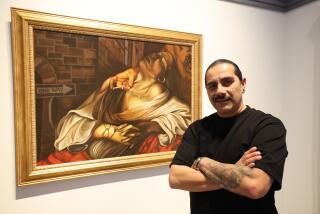Getting back to the land
In 1959, Walter de Maria envisioned tuxedoed men and bejeweled women watching “inexperienced people” dig a hole with a steam shovel on a vacant acre of land near an art-loving city while music played and parents screamed, “Get that bulldozer away from my child.”
This conception is often credited as the first land art proposal and the tip of the iceberg of some of the most provocative -- and monumental -- art of its time. Fifty years later, the form has evolved into one with quieter, more ephemeral aspirations. Far from the macho, heroic projects that were the hallmark of the first generation of earth artists -- some of whom, like Michael Heizer, have spent close to 40 years moving tons of dirt to create massive, remote sculptural environments -- “leave no trace,” or at least, leave an ecologically enhancing trace, are the watchwords of many artists working in the field.
Not surprisingly, New Mexico, with its near mystical natural beauty and vast open spaces, has become a hub of activity. This summer and fall, visitors will get to survey a wide swath of new work by this younger generation of artists, which has been brought together in “LAND/ART,” a festival of coordinated exhibitions, lectures, symposia, film screenings (such as Nancy Holt and Robert Smithson’s “Mono Lake”), blogs, public installations and site-specific sculptures organized by the 516 Arts gallery in Albuquerque.
Suzanne Sbarge, director of 516 Arts and LAND/ART’s guiding light, says this is “the biggest arts collaboration” to occur in New Mexico, and it has proved extremely popular. Visitors have been seen wandering the streets of Albuquerque with the project’s tabloid brochure trying to hunt down installations. The public interest has also caused the city “to rethink” some of the ways it handles public art, supporting more temporary installations. There is talk about whether the one-time project could grow into a biannual or tri-annual event.
Current projects include visits to Charles Ross’ monumental “Star Axis” -- a 30-year earth-moving project to erect an 11-story star-gazing apparatus in a remote location 125 miles north of Albuquerque -- and Matthew McConville’s small, contemplative Hudson River School-style oil paintings at Richard Levy Gallery that memorialize the great earthworks of the 1960s and ‘70s. For those who can’t visit “Star Axis,” there is an exhibition of three decades of Edward Ranney’s photographs of the construction process as well as numerous group shows organized in different venues around themes such as virtual environments and environmental activism. Site-specific installations are designed to draw visitors to different parts of the state. Though not technically part of “LAND/ART,” those seeking De Maria’s work can book a night at the “Lightning Field” in Quemado, N.M., see a grid of metal poles sticking out of the ground and, with luck, catch a rare glimpse of the electromagnetic fireworks the artist hoped would materialize.
One of the event’s advisors, artist Bill Gilbert, chairs the Land Arts of the American West program at the University of New Mexico. He regularly takes his students to Robert Smithson’s “Spiral Jetty” in Utah and James Turrell’s “Roden Crater” in Arizona but finds that although his students are awed by what they call the work of the “grandfathers,” they are more interested in creating work that has a more “empathetic relationship to the land rather than making huge gestures.” As a result, a lot of the work exists only in maps, videos and photographs taken of transient events and objects.
Gilbert’s mixed media project, “Matter of Fact: Walk to Work,” part of a group show at 516 Arts, is typical of this way of working. In a gallery setting, the project consists of a long narrow topographical map made of dirt and sand, which sits on the floor beneath a video monitor that shows a digital overview of the same terrain. It is narrated by an audio recording of Gilbert talking his way through a three-day hike, which parallels his regular 50-mile highway commute of the last 20 years from his home in Cerillos, to the university.
With the help of a GPS positioning device, maps and camping gear, Gilbert set out to walk a straight line between the points. In the process, he blazed trails down rocky slopes, encountered late spring snowstorms, wildlife and barbed wire fences before hitting the outskirts of Albuquerque. The last five hours of his excursion were spent traversing the successive rings of housing developments and retail malls, which provide a history of the unbridled urban expansion that turned this small western pueblo on the banks of the Rio Grande into one of the fastest-growing cities in the West.
Also at 516 Arts are photographs by Basia Irland of ecologically based riparian restoration “performances” in which she launches what she calls “ice books” -- large blocks of ice embedded with indigenous seeds -- on rivers all over the world, including the Rio Grande. When the ice melts, the seeds are released and carried on the river’s currents to sprout along the banks.
The City of Albuquerque Open Space in the Bosque -- a restored riparian corridor and birder’s paradise, which runs through the city -- hosts a collection of new works commissioned for the occasion. Artists were asked to focus on three elements, the removal of which would help restore the Bosque: the invasive Salt Cedar, debris from fallen cottonwood trees and the Jetty Jacks, large, rusting iron tripods that were installed in the river by the Army Corps of Engineers decades ago to prevent flooding. (Their previous use was as a tank deterrent in World War II.)
Robert Wilson, who grew up near the Bosque, contributed a minimalist cube made from the steel wires connecting the Jetty Jacks and containing the trunk of a dead cottonwood tree. As the winner of a civic competition for a permanent sculpture tied to LAND/ART, Wilson will also eventually build a large-scale grid of Jetty Jacks designed to look like the flocks of migrating cranes that make annual trips over the area.
The Albuquerque Museum is hosting “Experimental Geographies,” curated by Nato Thompson and presenting an international array of artists. A video by Julia Meltzer and David Thorne explores the cultural and political shifts that manipulate the urban landscape through the on-again, off-again development of a projected hotel and mosque in downtown Damascus. A pair of videos by the European collective Multiplicity charts two geographically comparable road trips through the West Bank territories, one with a passenger with an Israeli passport, a second with a passenger with a Palestinian passport.
The Los Angeles-based Center for Land Use Interpretation contributes a new site-specific project at the end of a dead-end road in a temporary building on a scruffy plot of dirt just south of the Albuquerque International Sunport. The site speaks volumes. It is near a police shooting range, an evacuation area, a garbage transfer area, the “back door” to a field test area for Sandia National Laboratories and the undeveloped site for a community of 50,000 homes.
“The idea is that by placing this innocuous building in this location, it will draw people into a part of town they don’t ordinarily see,” says CLUI’s founder Matthew Coolidge. Inside, there is a low-tech exhibition of maps and photographs of Los Alamos National Laboratory’s weapons-engineering facility, the radio astronomy telescopes at the Very Large Array, the Ground-based Electro-Optical Deep Space Surveillance (GEODSS) facility at White Sands Missile Range, and other high-tech installations. In short, the enchantment that Coolidge is looking at in the Land of Enchantment is the state’s prodigious fascination with technology.
“The man-made sun was created and nurtured here,” says Coolidge of New Mexico. “We’re looking at the relationship of that technology to the terrestrial transformation that goes on to defend against it. We’re staring at a high-tech mimicking of the natural order, the interaction of the ground and sky in physical, practical and spiritual terms.” By placing the exhibition at a dead end outside the center of town, Coolidge is forcing visitors to take a journey outside their comfort zone. When they turn to leave, Coolidge -- like most of the other artists in the show -- wants them to take away a new perception of the Earth and their place in it.
calendar@latimes.com
More to Read
The biggest entertainment stories
Get our big stories about Hollywood, film, television, music, arts, culture and more right in your inbox as soon as they publish.
You may occasionally receive promotional content from the Los Angeles Times.






